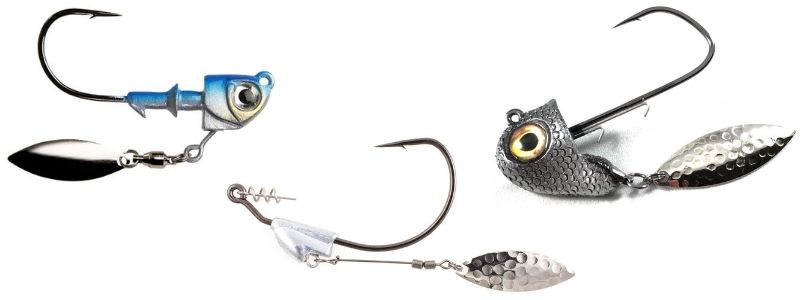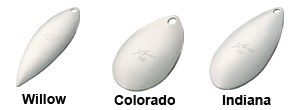
Underspins come in a few styles that have slightly different presentations. But at the end of the day, an underspin is basically a swim jig / swimbait with a blade attached to the bottom. The blade spins and vibrates as the bait travels through the water, giving it some additional action and flash.
Every underspin is made up of a weighted hook that’s rigged with a soft plastic jig trailer. In most cases, underspins are paired with a paddle tail style trailer. One of the best underspin combinations is a 5/8 oz BiCO Bottom-Spin paired with a 4.8″ Keitech FAT Swing Impact trailer.
Types of Underspins
There are a few different styles of underspins, but the two main types are jig head underspins and belly weight underspins. The biggest difference being that the belly weight style is weedless.
The area you are fishing will tell you which one to use, so you should always carry both if you plan to cover water effectively. The key is to use the jig head style with an exposed hook whenever you can. There are a list of advantages to using this style, but let’s take a closer look at the different types of underspins.
Underspin Jig Heads
These underspin jigs have an exposed hook, and are not the best option for heavily weeded areas. With that said, there are some models this style that are equipped with a weedguard. But for the most part these baits feature a fully exposed hook.
The only disadvantage of this style of underspin is the limited areas you can fish it. The exposed hook puts you at high risk of getting snagged and either ruining your presentation, or worse, losing your lure.
But don’t shy away from all weeds with these baits. Fish them the way you would a spinnerbait, in light vegetation. Underspins are great for fishing sparse grass beds.
This style of underspin is ideal for for targeting schooling bass that are feeding on baitfish in open water. They are great for fishing along the edge of weedlines and docks.
Weedless Underspins
When you need to target fish in areas with vegetation, it’s best to used a weedless underspin. These baits are completely weedless, since the hook point gets buried in the plastic of the trailer.
There are two disadvantages to using a weedless underspin instead of one with an exposed hook. The first is the amount of trailers you will go through.
The way a trailer is rigged on a weedless underspin will cause more damage to the trailer as it catches fish. The plastic will tear a lot easier during a fight than if the trailer were threaded along the shank of the hook.
The other disadvantage is less hookups. Weedless underspins hookup with fish exceptionally well, but it’s hard to beat the hookup ratio of a fully exposed hook.
Screw-In Underspin Blades
There is also the option of adding an underspin blade to an existing swim jig or swimbait. These are just blades attached to a screw lock that screws into the belly of a bait.
This perfect if you already have a bait that you like and want to add some flash to it. It’s great for when trying to figure out what is triggering bites on a specific day. Sometimes the flash is too much and other times it’s exactly what was missing.
Underspin Blades
Typically underspin blades are on the smaller side, since there isn’t much clearance for the blade to spin. That’s why you will more often than not see them equipped with a willow leaf blade.

They are available with all the commonly known blades, but mainly the big three: the willow, the Colorado, and the Indiana. The blades can also be swapped out on most underspins via the split ring.
Underspin Trailers
You never fish an underspin without a jig trailer. Like we said above, this is most often a swimbait paddle tail style trailer. In addition to the blade, this is what gives the bait its action and fills out the profile of the bait.
Of course there are times when a no-action trailer works great. Aaron Maren’s, for example, finished second in the 2004 Bassmaster Classic when he was rigging his underspin with a Zoom Superfluke.
There is such a thing as too much action, and the key is to figure out what the bass want that day through testing. Luckily it’s easy enough to switch out trailers, or if you have two rods rigged up that’s even better. Consecutive casts to the same spot is the ideal way to figure it out.
Fishing Underspins
Underspins are power fishing lures and are always on the move. Many anglers use them as search bait. They can be effective deep or shallow and trigger bites at all times of year.
They fall in to the family of swimjigs, bladed jigs, spinnerbaits, and smaller swimbaits. So if you’re familiar with fishing these baits you are ahead of the game.
Of course the best time to use an underspin is when bass are feeding on shad or other types of baitfish. These lures mimic a baitfish and with the additional flash provided they will stand out from the crowd. That’s why running an underspin through a school of baitfish can be deadly.
Let It Sink
Another underspin technique is to let the bait sink on the initial cast. This gives the bait a nice presentation as it falls. With the trailer kicking lightly and blade slowly turning as it descends, many times this will trigger a bite.
This can either be to the bottom or to the target depth you want the bait to run to. Whichever it is, keep close attention to the rod and line as it sinks. Especially the second you initiated the action, the sudden change in direction can trigger a reaction strike.
Sub Surface Waking
Running underspins just under the surface is a great technique in topwater conditions. This is when the water has a slight ripple and you almost work this bait like a wakebait.
This creates a light disturbance on the water which adds to the presentation. It allows for a full visual of the spinning blade action for bass looking up at it from below.

